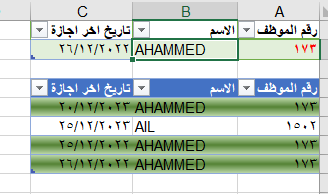نجوم المشاركات
Popular Content
Showing content with the highest reputation on 25 ديس, 2023 in all areas
-
السلام عليكم ورحمة الله تعالى وبركاته انا بصدد تصميم قاعدة بيانات فى عملى وتباعا ان شاء الله اضع بين اياديكم خلاصة مجهود وتعليم سنوات اولا تسجيل الاخطاء ومعالجتها اولا موديول باسم : basErrorHandling Public strProcessName As String ' The name of the table where errors are logged Public Const TABLE_ERROR_LOG_NAME As String = "tblErrorLog" ' Subroutine to log errors in the error log table Sub ErrorLog(ByVal intErrorNumber As Integer, ByVal strErrorDescription As String, ByVal strErrorProcessName As String) On Error GoTo Err_ErrorLog Dim strErrorMsg As String strErrorMsg = "Error " & intErrorNumber & ": " & strErrorDescription ' Show a message to the user MsgBox strErrorMsg, vbQuestion, strErrorProcessName ' Log error details in the error log table With CurrentDb.OpenRecordset(TABLE_ERROR_LOG_NAME) .AddNew ![ErrorNumber] = intErrorNumber ![ErrorDescription] = Left$(strErrorDescription, 255) ![ErrorProcessName] = strErrorProcessName ![ErrorDate] = Now() ![userName] = GetLoggedUserName() .Update .Close End With Exit_ErrorLog: Exit Sub Err_ErrorLog: ' Error message in case of an unexpected issue strErrorMsg = "An unexpected situation arose in your program." & vbNewLine strErrorMsg = strErrorMsg & "Please write down the following details:" & vbNewLine & vbNewLine strErrorMsg = strErrorMsg & "Calling Proc: " & strErrorProcessName & vbNewLine strErrorMsg = strErrorMsg & "Error Number " & intErrorNumber & vbNewLine & strErrorDescription & vbNewLine & vbNewLine strErrorMsg = strErrorMsg & "Unable to record because Error " & Err.Number & vbNewLine & Err.Description & vbNewLine strErrorMsg = strErrorMsg & "Occurred at Line: " & Erl MsgBox strErrorMsg, vbCritical, "ErrorLog()" Resume Exit_ErrorLog End Sub ' Subroutine to handle and log errors ' This subroutine checks for errors and logs them using the ErrorLog function. ' It clears the error after logging it. ' Parameters: ' - strProcName: The name of the procedure where the error occurred. Public Sub HandleAndLogError(ByVal strProcName As String) ' Check for errors If Err.Number <> 0 Then ' Handle the error and log it Call ErrorLog(Err.Number, Err.Description, strProcName) ' Clear the error Err.Clear End If End Sub ' Function to get the logged username, or return "N/A" if not available Function GetLoggedUserName() As String On Error Resume Next Dim userName As String userName = Environ("USERNAME") If Err.Number <> 0 Then userName = "N/A" Err.Clear End If On Error GoTo 0 GetLoggedUserName = userName End Function ---------------------------------------------------------------------- ثانيا مويدول باسم : basInitialization ' The name of the table where errors are logged Public Const TABLE_ERROR_LOG_NAME As String = "tblErrorLog" ' Subroutine to initialize the application Sub InitializeApplication() ' Initialize the error log table if it doesn't exist If Not IsErrorLogTableInitialized() Then CreateErrorLogTable End Sub ' Check if the error log table exists and is initialized Function IsErrorLogTableInitialized() As Boolean Dim db As DAO.Database Dim rs As DAO.Recordset ' Use error handling to check if the error log table exists On Error Resume Next Set db = CurrentDb Set rs = db.OpenRecordset(TABLE_ERROR_LOG_NAME) On Error GoTo 0 ' Check if the error log table is initialized (contains necessary fields) If Not rs Is Nothing Then On Error Resume Next rs.MoveFirst IsErrorLogTableInitialized = (Err.Number = 0) And (rs.Fields.Count >= 6) On Error GoTo 0 rs.Close End If Set rs = Nothing Set db = Nothing End Function ' Subroutine to create the error log table Sub CreateErrorLogTable() On Error Resume Next Dim db As DAO.Database Set db = CurrentDb ' Check if the table already exists If Not IsTableExists(TABLE_ERROR_LOG_NAME, db) Then ' Define the SQL code to create the table Dim strSQL As String strSQL = "CREATE TABLE " & TABLE_ERROR_LOG_NAME & " (" & _ "ID AUTOINCREMENT PRIMARY KEY, " & _ "ErrorProcessName TEXT(255), " & _ "ErrorNumber LONG, " & _ "ErrorDescription MEMO, " & _ "ErrorDate DATETIME, " & _ "UserName TEXT(255));" ' Execute the SQL command to create the table directly DoCmd.RunSQL strSQL End If Set db = Nothing On Error GoTo 0 End Sub ' Function to check if a table exists in the database Function IsTableExists(tableName As String, Optional db As DAO.Database) As Boolean ' Use DLookup to check for the existence of the table in MSysObjects On Error Resume Next Set db = IIf(db Is Nothing, CurrentDb, db) IsTableExists = Not IsNull(DLookup("Name", "MSysObjects", "Name='" & tableName & "'")) On Error GoTo 0 End Function وظيفة الموديول هو تهئة ما اريد لقاعدة البيانات البدء به ومن خلاله ---------------------------------------------------------------------- 3- نموذج البداية وليكن الان باسم frmInitialization وفى حدث عند التحميل نضع الكود الاتى Private Sub Form_Load() strProcessName = "Form Load : frmIntialization" On Error Resume Next ' Initialize the application when the startup form is loaded. InitializeApplication ' Add calls to the initialized special functions through which you want the database to be booted ' Or add specify the codes through which you would like to process the data later according to the requirements of your design ' Set the current procedure name (you can adjust the procedure name as needed) If Err.Number <> 0 Then ' Handle the error (display a message) Call ErrorLog(Err, Error$, strProcessName) ' Clear the error Err.Clear End If End Sub النتيجة المرغوب فى الخصول عليها : عند تشغيل القاعدة فى المرة الأولى تنشئ جدول تسجيل الأخطاء من تلقاء نفسها باسم الروتين او الحدث ورقم الخطاء والوصف المتطلبات عند اعداد الاكواد تباعا نمرر اسم الروتين من خلال المتغير strProcessName كما فعلت فى الحدث السابق للنموذج: strProcessName = "Form Load : frmIntialization" لو حدث اى خطأ مستقبلا سوف يتم تسجيله حتى يستطيع مطور النظم او القائم على اعمال صيانة قواعد البيانات او المصمم معرفة مكان حدوث الخطأ الشق الثانى نقوم بعمل الايقاف للاخطا ليستكمل الكود عمله حتى لو وجودت اى اخطاء من خلال : On Error Resume Next بعد كتابة الكود كما نريد وبعد ان ننتهى منه نضع الشرط التالى : If Err.Number <> 0 Then بذلك نضع شرط عند الدوران على الكود لتنفيذه فى حالة وجود خطأ اولا اظهر رسالة الخطأ حتى يعلم المستخدم سبب المشكلة ثم استدعى الدالة لتسجيل هذا الخطأ ويتم ذلك من خلال Call ErrorLog(Err, Error$, strProcessName) الان هذه بداية احترافية وعلى اسس صحيحة ومفيدة للمستقبل ..... يتبع HandleAndLogError.accdb3 points
-
2 points
-
آسف ما كنت مركز على المطلوب تماما، كان تركيزي منصب على التنسيق الشرطي 🙂 حضور وإنصراف_03.xlsb2 points
-
يمكن عمل ذلك من خلال استخدام الربط المتأخر (Late Binding) أو الربط المتقدم (Early Binding) وهذا يعتمد على الاحتياجات الخاصة بالتطبيق الذي تقوم بتطويره وعلى الاعتبارات التي ترغب في مراعاتها الربط المتأخر (Late Binding): المرونة: يوفر المزيد من المرونة في حال تحتاج إلى تشغيل التطبيق على إصدارات مختلفة من تطبيق Microsoft Office دون الحاجة إلى إعادة كتابة الشيفرة لا يتطلب تحديد مراجع (References) محددة والتى تختلف تبعا لاختلاف اصدار الأكسس التوافق: يسمح بالتوافق مع تطبيقات Office على أنظمة التشغيل المختلفة بشكل أفضل التحقق من وجود الكائنات: يتطلب التحقق اليدوي من وجود الكائنات أو استخدام الكائنات بدون تحقق مسبق الربط المتقدم (Early Binding): الأداء: قد يكون الربط المتقدم أسرع من الربط المتأخر لأنه يتم تحديد الكائنات في وقت التصميم وليس في وقت التشغيل التحقق التلقائي: يتيح لك IntelliSense والتحقق التلقائي في وقت الكتابة، مما يسهل استكشاف واستخدام الكائنات المتاحة الوثائق والدعم: يوفر تحديد مراجع VBA معلومات وثائق أفضل ودعمًا تلقائيًا للأوامر والخصائص الختام: إذا كنت بحاجة إلى أقصى قدر من المرونة والتوافق وليس لديك اهتمام بالتحقق التلقائي والأداء الأقصي يمكنك استخدام الربط المتأخر إذا كان الأداء والتحقق التلقائي والوثائق المفصلة هي الأمور الرئيسية قطعا سوف تفضل استخدام الربط المتقدم عند استخدام الربط المتقدم يجب أن تأخذ في اعتبارك أن توفر ملفات التعريف (المراجع) قد تتغير مع إصدارات مختلفة من تطبيقات Office لذا يجب عليك تحديثها بناءً على الإصدار الذي يتم استخدامه طيب بالنسبة لى سوف افضل الربط المتقدم (Early Binding) اسباب التفضيل : يهمنى الأداء والمرونة والسرعة وان شاء الله اقدم لكم افكار عبقرية تقدم الاستفادة القصوى دون اى عناء فى المستقبل حيث تمكنت من معالجة السلبيات ان وجدت وهى كالاتى المكتبات - تم علاج مشكلة المكتبات فى هذا الموضوع : library reference: حفظ واسترجاع المكتبات المستخدمة( وداعا لفقد المكتبات بعد اليوم ) - علاج مشكلة اعادة كتابة الاكواد مرارا وتكرارا باستخدام موديول ذكى ولماح وشاطر طيب اولا اسم الموديول : basFileUtilityKit المرجع الذى يجب التأكد من اضافته : Microsoft Office 16.0 Object Library طبعا الرقم 16.0 قد يكون 14.0 أو ....... الخ يختلف تبعا لاصدار الاكسس تم استخدام Enumerated لاضفاء المرونة هو نوع بيانات يتكون من مجموعة من القيم المسماة تسمى العناصر أو الأعضاء أو التعداد أو التعداد من النوع أسماء العداد عادة ما تكون معرفات تتصرف كثوابت في لغة البرمجه يمكن أن يُنظر إلى النوع الذي تم تعداده باعتباره اتحادًا مميزًا من نوع الوحدة الدوال داخل الموديول كالاتى ' Enumeration for the types of file dialogs Enum EnumFileDialogType msoFileDialogFilePicker = 1 msoFileDialogFolderPicker = 4 End Enum ' Enumeration for different file extensions Enum EnumFileExtensions AllFiles TextFiles ExcelFiles ImageFiles VideoFiles AudioFiles PDFFiles WordFiles ' You can add additional file extensions as needed here End Enum ' Enumeration for different options related to file paths Enum EnumOptionFile FilePathWithFileName = 1 FilePathWithoutFileName = 2 FileNameWithExtension = 3 FileNameWithoutExtension = 4 FileExtensionOnly = 5 End Enum Public ChosenFilePaths() As String Dim TempChosenFilePaths() As String ' Check if the Microsoft Office Object Library is referenced ' Make sure to go to Tools > References and select the appropriate version ' e.g., "Microsoft Office 16.0 Object Library" for Office 2016 ' Function to open the file dialog and return the selected file paths Function GetFileDialog(Optional ByVal EnumFileExtension As EnumFileExtensions = AllFiles, Optional ByVal AllowMultipleFiles As Boolean = False) As Variant Dim i As Integer Dim fileDialogObject As Object Dim FilePaths() As String ' Use TempChosenFilePaths as a temporary storage ReDim TempChosenFilePaths(1 To 1) Set fileDialogObject = Application.FileDialog(EnumFileDialogType.msoFileDialogFilePicker) With fileDialogObject .Title = "Select File" .AllowMultiSelect = AllowMultipleFiles .Filters.Clear ' Adding filters based on the selected file extension Select Case EnumFileExtension Case EnumFileExtensions.AllFiles .Filters.Add "All Files", "*.*" Case EnumFileExtensions.TextFiles .Filters.Add "Text Files", "*.txt" Case EnumFileExtensions.ExcelFiles .Filters.Add "Excel Files", "*.xlsx; *.xls" Case EnumFileExtensions.ImageFiles .Filters.Add "Image Files", "*.jpg; *.jpeg; *.png; *.gif" Case EnumFileExtensions.VideoFiles .Filters.Add "Video Files", "*.mp4; *.avi; *.mov" Case EnumFileExtensions.AudioFiles .Filters.Add "Audio Files", "*.mp3; *.wav; *.ogg" Case EnumFileExtensions.PDFFiles .Filters.Add "PDF Files", "*.pdf" Case EnumFileExtensions.WordFiles .Filters.Add "Word Files", "*.docx; *.doc" ' You can add additional file extensions as needed here End Select If .Show = -1 Then ' ReDim the array to the number of selected items ReDim FilePaths(1 To .SelectedItems.Count) ' Populate the array with selected item paths For i = 1 To .SelectedItems.Count FilePaths(i) = .SelectedItems(i) ' Add to TempChosenFilePaths TempChosenFilePaths(UBound(TempChosenFilePaths)) = FilePaths(i) ReDim Preserve TempChosenFilePaths(1 To UBound(TempChosenFilePaths) + 1) Next i ' Return the array GetFileDialog = JoinFilePaths(FilePaths) ' Update ChosenFilePaths with the temporary values ChosenFilePaths = TempChosenFilePaths ' Clear TempChosenFilePaths Erase TempChosenFilePaths Else ' Return an empty string if no file is selected GetFileDialog = "" End If End With ' Set file dialog object to nothing Set fileDialogObject = Nothing End Function ' Function to join paths and set them to the global variable Function JoinFilePaths(paths() As String) As String JoinFilePaths = Join(paths, vbCrLf) End Function ' Function to check if ListBox contains a specific item Function ListBoxContainsItem(listBox As Object, item As String) As Boolean Dim i As Integer ListBoxContainsItem = False For i = 0 To listBox.ListCount - 1 If listBox.Column(0, i) = item Then ListBoxContainsItem = True Exit Function End If Next i End Function ' Subroutine to add paths to ListBox in the form Sub AddToFormListBox(frm As Object, paths() As String, ListBoxName As String, Optional ClearListBox As Boolean = True) Dim i As Integer Dim listBoxControl As Object ' Check if frm is not Nothing If Not frm Is Nothing Then ' Check if ListBox with the specified name exists in the form's controls On Error Resume Next Set listBoxControl = frm.Controls(ListBoxName) On Error GoTo 0 ' If ListBox control exists, add or clear items If Not listBoxControl Is Nothing Then ' Clear ListBox if ClearListBox is True If ClearListBox Then listBoxControl.RowSource = "" End If ' Add unique non-empty items to ListBox For i = LBound(paths) To UBound(paths) If Trim(paths(i)) <> "" And Not ListBoxContainsItem(listBoxControl, paths(i)) Then listBoxControl.AddItem paths(i) End If Next i Else ' Handle the case where ListBox control does not exist MsgBox "ListBox with name '" & ListBoxName & "' not found in the form.", vbExclamation End If End If End Sub ' Subroutine to add paths to Access table Sub AddToAccessTable(tableName As String, paths() As String) Dim db As DAO.Database Dim rs As DAO.Recordset Dim i As Integer Dim filePath As String ' Open the database Set db = CurrentDb ' Open the table Set rs = db.OpenRecordset(tableName, dbOpenDynaset) ' Add each non-empty and non-duplicate path to the table For i = LBound(paths) To UBound(paths) filePath = Trim(paths(i)) ' Check if the path does not already exist in the table If filePath <> "" And DCount("*", tableName, "FilePath='" & filePath & "'") = 0 Then rs.AddNew rs.Fields("FilePath").Value = filePath rs.Update End If Next i ' Close the recordset and database rs.Close Set rs = Nothing Set db = Nothing End Sub ' Function to open the folder dialog and return the selected folder path Function GetFolderDialog() As String Dim folderDialogObject As Object Set folderDialogObject = Application.FileDialog(EnumFileDialogType.msoFileDialogFolderPicker) With folderDialogObject .Title = "Select Folder" .AllowMultiSelect = False .Show End With If folderDialogObject.SelectedItems.Count > 0 Then GetFolderDialog = folderDialogObject.SelectedItems(1) Else ' Handle the case where no folder is selected MsgBox "No folder selected.", vbExclamation GetFolderDialog = "" End If Set folderDialogObject = Nothing End Function ' Function to get the desired option for a file path Function GetFileOption(ByRef filePath As String, Optional ByRef EnumOptionFile As EnumOptionFile = FilePathWithFileName) As String ' Check if the file exists If FileExists(filePath) Then ' Get file File Option using GetFileOption function Select Case EnumOptionFile Case FilePathWithoutFileName GetFileOption = Left(filePath, InStrRev(filePath, "\")) Case FilePathWithFileName GetFileOption = filePath Case FileNameWithExtension GetFileOption = Mid(filePath, InStrRev(filePath, "\") + 1) Case FileExtensionOnly GetFileOption = Right(filePath, Len(filePath) - InStrRev(filePath, ".")) Case FileNameWithoutExtension GetFileOption = Mid(filePath, InStrRev(filePath, "\") + 1, InStrRev(filePath, ".") - InStrRev(filePath, "\") - 1) End Select Else ' Return an empty string if the file does not exist GetFileOption = "" End If End Function ' Function to get additional information about a file Function GetFileInfo(filePath As String) As String ' Check if the file exists If FileExists(filePath) Then ' Get file information using GetFileInfo function Dim fileInfo As String fileInfo = "File Information:" & vbCrLf fileInfo = fileInfo & "Path: " & filePath & vbCrLf fileInfo = fileInfo & "Size: " & FileLen(filePath) & " bytes" & vbCrLf fileInfo = fileInfo & "Created: " & FileDateTime(filePath) & vbCrLf GetFileInfo = fileInfo Else ' Return an empty string if the file does not exist GetFileInfo = "" End If End Function ' Function to create a new folder Function CreateNewFolder(parentPath As String, folderName As String) As String Dim newFolderPath As String newFolderPath = parentPath & "\" & folderName MkDir newFolderPath CreateNewFolder = newFolderPath End Function ' Function to check if a file exists Function FileExists(ByVal filePath As String, Optional findFolders As Boolean = False) As Boolean Const vbReadOnly As Long = 1 Const vbHidden As Long = 2 Const vbSystem As Long = 4 Const vbDirectory As Long = 16 Dim attributes As Long attributes = (vbReadOnly Or vbHidden Or vbSystem) If findFolders Then attributes = (attributes Or vbDirectory) ' Include folders as well. Else ' Strip any trailing slash, so Dir does not look inside the folder. Do While Right(filePath, 1) = "\" filePath = Left(filePath, Len(filePath) - 1) Loop End If ' If Dir() returns something, the file exists. FileExists = (Len(Dir(filePath, attributes)) > 0) End Function من خلال تلك الوحدة النمطية يمكن عمل الاتى 1- انتقاء مسار مجلد من خلال الدالة : GetFolderDialog الاستدعاء: GetFolderDialog 2- انتقاء مسار ملف / ملفات من خلال الدالة : GetFileDialog الاستدعاء:GetFileDialog(EnumFileExtensions, AllowMultipleFiles) -قائمة EnumFileExtensions التى تضفى مرونة فى تحديد نوع الملفات التى تريد انتقائها - AllowMultipleFiles تحديد ما اذا كنت تريد انتقاء ملف واحد فقط لتكون False , أو ملفات متعددة لتكون True 3-استخلاص معلومات الملف من خلال الدالة : GetFileInfo الاستدعاء:GetFileInfo(filePath) 4- التحكم فى خيارات الملف / الملفات من خلال الدالة : GetFileOption وهى (المسار كاملا مع اسم الملف , مسار الملف فقط , اسم الملف مع الامتداد فقط , امتداد الملف فقط ) الاستدعاء:GetFileOption(filePath , EnumOptionFile) 5- اضافة مسار الملف / الملفات الذى يتم انتقاءه كاملا او حسب ما تريد من الخطوة الرابعة السابقة الى مربع قائمة وذلك من خلال الدالة : AddToFormListBox الاستدعاء: 6- اضافة مسار الملف / الملفات الذى يتم انتقاءه كاملا او حسب ما تريد من الخطوة الرابعة الى جدول من خلال الدالة: AddToAccessTable الاستدعاء: يتبع...... FileDialog.accdb2 points
-
طبعا سوف اضع تباعا موضوع خاص لكل نقطة ويتم ربط الموضوعات بالتتابع من خلال وضع الرابط لها هنا ليكون المنتدى غنى بالموضوعات المنفصلة على وجه العموم وليكون الموضوع هنا مرجع متكامل على وجه الخصوص ملحوظة: ساعتمد فى المرفقات كذلك على ان يكون كل مرفق خاص بالفكرة او الالية التى تخصه فقط تسهيلا على الجميع لدراسة كل فكرة على حده لتحقيق الاستفادة القصوى الجزء الثانى: انتقاء المجلدات والملفات والعمليات المختلفة و المرتبطه بها >---->> من هنا2 points
-
2 points
-
تفضل اخي الكريم الملف كما تريد فضلا ان كان هذا طلبك الضغط على افضل اجابة 🤍 New Microsoft Access Database (2).accdb1 point
-
1 point
-
1 point
-
1 point
-
1 point
-
الكود: Sheets("Base").Select Range("D7:AH15").Select Selection.FormatConditions.Delete Selection.FormatConditions.Add Type:=xlExpression, Formula1:= _ "=WEEKDAY(D$6)=" & vbFriday Selection.FormatConditions(Selection.FormatConditions.Count).SetFirstPriority With Selection.FormatConditions(1).Interior .PatternColorIndex = xlAutomatic .ThemeColor = xlThemeColorAccent2 .TintAndShade = 0.399945066682943 End With Selection.FormatConditions(1).StopIfTrue = False MsgBox "Done"1 point
-
1 point
-
هى طبعا الفكرة حلوة بس...... فعلا فى الوقت الراهن لا املك الادوات اللازمة ولا رفاهية الوقت اننى دائما اضع نصب عينى عند تطبيق الفكرة بقدر الامكان تحقيق المتطلبات الاتيه 1- ان تكون عامة بقدر الامكان بحيث يسهل استخدامها فى جميع المجالات والحلات وفق الرغبات دون اى قيود قدر الامكان ليسهل 2- المرونة بحيث تتم كتابة الكود مرة واحدة وقد يكون وقت كتابته بذل الجهد فى الافكار كبير والعناء فى التنفيذ اكبر وقت تطويع الكود لتفيذ الفكرة ولكن قمة المتعة فى سهولة الاستدعاء مستقبلا ويعلم الله لما تم بذل الوقت والجهد وكان الحصاد بتلك المرونة والسهولة خطر على بالى مشاركة اخوانى واحبابى هذه الافكار التى تسهل عليهم مستقبلا الكثير من الوقت فى كتابة الاكواد وتقديم الحلول المرنة لحصاد النتائج المبهرة دون اى عناء يذكر1 point
-
طلب اضافى ^_^ لو تعمل شروحات فيديو على اليوتيوب اعتقد هيكون معاك المجال اوسع لاضافة المزيد من الشرح والتوضيح1 point
-
1 point
-
واااااو ما شاء الله شرح ومعلومات مهمه وجديده على ما شاء الله تبارك الله ربنا يزيدك من علمه ويجعله فى ميزان حسناتك الف شكر على المجهود الجبار ده1 point
-
وعليكم السلام ورحمة الله وبركاته.. ما شاء الله تبارك الرحمن .. 🌹🌷 شغل معلمين يحتاجله 10 سطل قهوة عشان تجيب كل التركيز اللي في العالم لراسك 😅👌 هدخله المكتبه ازاي ده ؟؟!!! 😂 شكر لك باش مهندس ومنتظرين التكملة 👍🏼😊1 point
-
اشكركم أساتذتى الكرام على سرعة إستجابتكم لى ولجميع أعضاء المنتدى الكريم وجعله الله عملكم فى ميزان حسناتكم @ابوخليل @kkhalifa19601 point
-
السلام عليكم اخي الكريم عمر ضاحي لايسعني إلا ان اقول لك ولكل من يساهم في حل الاسئلة المطروحة في هذا المنتدى جزاك الله وجزاكم كل خير وعاشت ايدك اخي الكريم1 point
-
وعليكم السلام -يمكنك بهذا https://stackoverflow.com/questions/67474397/alternative-of-filter-function-on-non-office-3651 point
-
كفوك الطيب اخوي موسى انا طرحتها هنا كاملة في المشاركة 14 .. ملف تكست _كامل الكود _ يمكنك الاطلاع عليه وعندي نسخة فيجوال بيسك6 منقولة هي التي اعمل عليها الملف التنفيذي1 point
-
1 point
-
يمطنط استخدام هذه المعادلة في الخلية Q2 =SUMIFS(tr_acc[عدد النقل],tr_acc[رقم الوش],N5,tr_acc[التاريخ],M5) بالوفيق1 point
-
السلام عليكم ورحمة الله وبركاته جواباً لطلبك الثاني أخي الكريم وبعد إذن من سبقني من الأساتذة الكرام وحسبما فهمت من سؤالك يمكنك وضع معادلة الأستاذ الكريم محمد صالح بشرطي المبلغ والسنتين والله أعلم في الخلية D14 :يمكنك وضع هذه المعادلة: =IF(AND($D$12=3521;$G$9=2);100%;SUM(G9*360;F9*30;E9)/720) والسلام عليكم.1 point
-
في الخلية D14 يمكنك استعمال هذه المعادلة على اعتبار أن السنة 360 يكون العامان 720 =SUM(G9*360,F9*30,E9)/720 بالتوفيق1 point
-
إخواني تفضلو المطلوب بدون داعي للأكواد على الإطلاق كله بالمعادلات (هتعجب الأخ جمال عبد السميع ملك المعادلات) List Sheet Names In New Sheet.rar1 point
.thumb.gif.27c4a79ce23abc61b721f833e6899131.gif)








(1).thumb.gif.3369bc21e7688379f05218e4ca64e807.gif)





